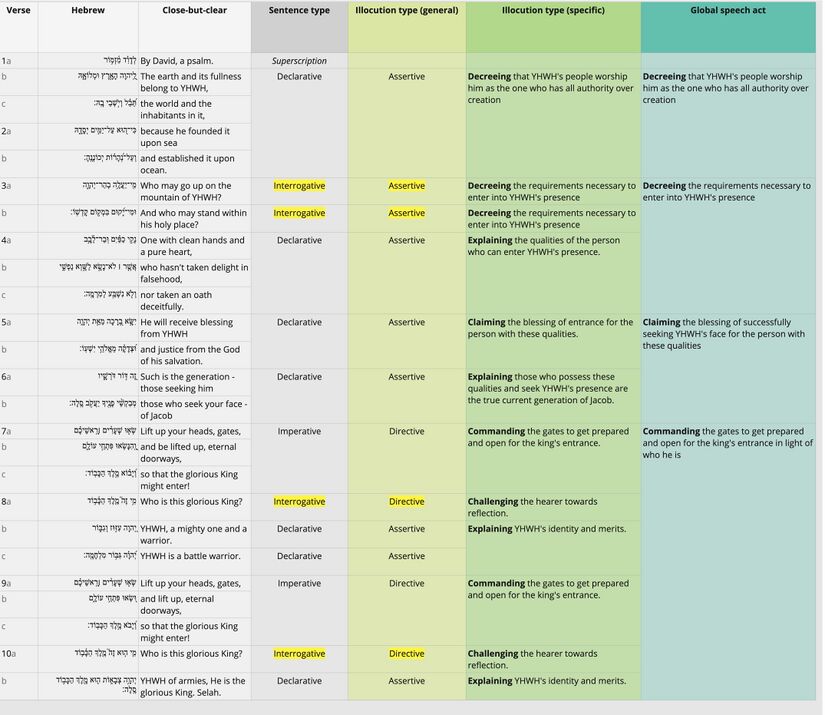Psalm 24 Discourse: Difference between revisions
From Psalms: Layer by Layer
Sarah.Milton (talk | contribs) (Created page with "Back to Psalm 24 {{LayerbyLayer |Chapter=24 }} =Macrosyntax= class=img-fluid|825px Notes. Word order: * '''v. 2a: ליהוה '''focus fronted (probably exclusive) * '''v. 2b: הוא '''focus fronted (probably verum/exclusive) * '''v. 2b-c:''' PPs''' על־ימים '''and '''על־נהרות '''fronted for poetic superimposition *''' v. 4b:''' PP''' לשׁוא '''pre-patient as either (1) repeating (in this case, preemptively) the s...") |
Sarah.Milton (talk | contribs) No edit summary |
||
| Line 19: | Line 19: | ||
* '''Vocative position vv. 7a/9a''': Tentatively, the medial-vocative simply slows down processing and partitions the line into manageable chunks (since the imperatival VP is 'all new'). Other explanations include mitigation/marking superiority of addressee (Revell 1996: 338 / Kim 2022: 187), dividing theme-rheme (Kim 2022: 191) or simply "poetic" (ibid.: 190) None of these are satisfying here. | * '''Vocative position vv. 7a/9a''': Tentatively, the medial-vocative simply slows down processing and partitions the line into manageable chunks (since the imperatival VP is 'all new'). Other explanations include mitigation/marking superiority of addressee (Revell 1996: 338 / Kim 2022: 187), dividing theme-rheme (Kim 2022: 191) or simply "poetic" (ibid.: 190) None of these are satisfying here. | ||
* '''Vocative position vv. 7b/9b''': According to Kim's (2022) understanding of a C-unit, פתחי עולם would be C-unit medial (as the resulting weyiqtol clause would be contained within the same C-unit), and either "focussing" the weyiqtol clause or at least delaying its utterance for higher prominence / attention-grabbing. I think that works here. | * '''Vocative position vv. 7b/9b''': According to Kim's (2022) understanding of a C-unit, פתחי עולם would be C-unit medial (as the resulting weyiqtol clause would be contained within the same C-unit), and either "focussing" the weyiqtol clause or at least delaying its utterance for higher prominence / attention-grabbing. I think that works here. | ||
=Speech Act Analysis= | |||
[[File:Psalm 024 - Speech Act Summary.jpg|class=img-fluid|825px]] | |||
</br> | |||
''For Visual, click "Expand" to the right'' | |||
<div class="mw-collapsible mw-collapsed"> | |||
[[File:Psalm 024 - Speech Act Table revised.jpg|class=img-fluid|825px]] | |||
</div> | |||
Revision as of 00:29, 5 June 2023
Back to Psalm 24
Macrosyntax
Notes.
Word order:
- v. 2a: ליהוה focus fronted (probably exclusive)
- v. 2b: הוא focus fronted (probably verum/exclusive)
- v. 2b-c: PPs על־ימים and על־נהרות fronted for poetic superimposition
- v. 4b: PP לשׁוא pre-patient as either (1) repeating (in this case, preemptively) the structure of 4c which has no object or (2) contrasting focus to the actions/attitudes of v. 4a
- Paragraph breaks are indicated by סלה and imperatives/vocatives from v.7ff.
- Vocative position vv. 7a/9a: Tentatively, the medial-vocative simply slows down processing and partitions the line into manageable chunks (since the imperatival VP is 'all new'). Other explanations include mitigation/marking superiority of addressee (Revell 1996: 338 / Kim 2022: 187), dividing theme-rheme (Kim 2022: 191) or simply "poetic" (ibid.: 190) None of these are satisfying here.
- Vocative position vv. 7b/9b: According to Kim's (2022) understanding of a C-unit, פתחי עולם would be C-unit medial (as the resulting weyiqtol clause would be contained within the same C-unit), and either "focussing" the weyiqtol clause or at least delaying its utterance for higher prominence / attention-grabbing. I think that works here.


